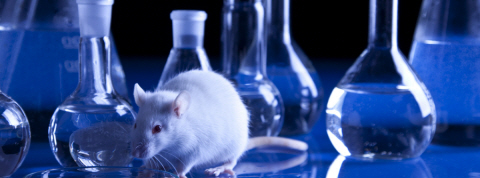
   |
[Debate/토론] (PC-003) Should Animals Be Used for Scientific or Commercial Testing?
최고관리자 | 17-04-09 23:09

An estimated 26 million animals are used every year in the United States for scientific and commercial testing. Animals are used to develop medical treatments, determine the toxicity of medications, check the safety of products destined for human use, and other biomedical, commercial, and health care uses. Research on living animals has been practiced since at least 500 BC.
Proponents of animal testing say that it has enabled the development of many life-saving treatments for both humans and animals, that there is no alternative method for researching a complete living organism, and that strict regulations prevent the mistreatment of animals in laboratories.
Opponents of animal testing say that it is cruel and inhumane to experiment on animals, that alternative methods available to researchers can replace animal testing, and that animals are so different from human beings that research on animals often yields irrelevant results.
Pros
1. Animal testing has contributed to many life-saving cures and treatments. The California Biomedical Research Association states that nearly every medical breakthrough in the last 100 years has resulted directly from research using animals. Experiments in which dogs had their pancreases removed led directly to the discovery of insulin, critical to saving the lives of diabetics. The polio vaccine, tested on animals, reduced the global occurrence of the disease from 350,000 cases in 1988 to 223 cases in 2012. Animal research has also contributed to major advances in understanding and treating conditions such as breast cancer, brain injury, childhood leukemia, cystic fibrosis, malaria, multiple sclerosis, tuberculosis, and many others, and was instrumental in the development of pacemakers, cardiac valve substitutes, and anesthetics. Chris Abee, Director of the University of Texas M.D. Anderson Cancer Center's animal research facility, states that "we wouldn't have a vaccine for hepatitis B without chimpanzees," and says that the use of chimps is "our best hope" for finding a vaccine for Hepatitis C, a disease that kills 15,000 Americans annually. If thalidomide had been properly tested on pregnant animals, its potential for causing severe birth defects would have been discovered before the drug became legal for human use.
2. There is no adequate alternative to testing on a living, whole-body system.Living systems like human beings and animals are extremely complex. Studying cell cultures in a petri dish, while sometimes useful, does not provide the opportunity to study interrelated processes occurring in the central nervous system, endocrine system, and immune system. Evaluating a drug for side effects requires a circulatory system to carry the medicine to different organs. Also, conditions such as blindness and high blood pressure cannot be studied in tissue cultures. Computer models can only be reliable if accurate information gleaned from animal research is used to build the models in the first place. Furthermore, even the most powerful supercomputers are unable to accurately simulate the workings of complex organs such as the brain.
3. Animals are appropriate research subjects because they are similar to human beings in many ways. Chimpanzees share 99% of their DNA with humans, and mice are 98% genetically similar to humans. All mammals, including humans, are descended from common ancestors, and all have the same set of organs (heart, kidneys, lungs, etc.) that function in essentially the same way with the help of a bloodstream and central nervous system. [17] Because animals and humans are so biologically similar, they are susceptible to many of the same conditions and illnesses, including heart disease, cancer, and diabetes.
4. Animals must be used in cases when ethical considerations prevent the use of human subjects. When testing medicines for potential toxicity, the lives of human volunteers should not be put in danger unnecessarily. It would be unethical to perform invasive experimental procedures on human beings before the methods have been tested on animals, and some experiments involve genetic manipulation that would be unacceptable to impose on human subjects before animal testing. The World Medical Association Declaration of Helsinki states that human trials should be preceded by tests on animals.
5. Animals themselves benefit from the results of animal testing. If vaccines were not tested on animals, millions of animals would have died from rabies, distemper, feline leukemia, infectious hepatitis virus, tetanus, anthrax, and canine parvo virus. Treatments for animals developed using animal testing also include pacemakers for heart disease and remedies for glaucoma and hip dysplasia. Animal testing has also been instrumental in saving endangered species from extinction, including the black-footed ferret, the California condor and the tamarins of Brazil. Koalas, ravaged by an epidemic of sexually transmitted chlamydia and now classified as endangered in some regions of Australia, are being tested with new chlamydia vaccines that may stall the animal's disappearance. The American Veterinary Medical Association (AVMA) endorses animal testing.
Cons
1. Animal testing is cruel and inhumane. According to Humane Society International, animals used in experiments are commonly subjected to force feeding, forced inhalation, food and water deprivation, prolonged periods of physical restraint, the infliction of burns and other wounds to study the healing process, the infliction of pain to study its effects and remedies, and "killing by carbon dioxide asphyxiation, neck-breaking, decapitation, or other means." The Draize eye test, used by cosmetics companies to evaluate irritation caused by shampoos and other products, involves rabbits being incapacitated in stocks with their eyelids held open by clips, sometimes for multiple days, so they cannot blink away the products being tested. The commonly used LD50 (lethal dose 50) test involves finding out which dose of a chemical will kill 50% of the animals being used in the experiment. The US Department of Agriculture (USDA) reported in 2010 that 97,123 animals suffered pain during experiments while being given no anesthesia for relief, including 1,395 primates, 5,996 rabbits, 33,652 guinea pigs, and 48,015 hamsters.
2. Alternative testing methods now exist that can replace the need for animals. In vitro (in glass) testing, such as studying cell cultures in a petri dish, can produce more relevant results than animal testing because human cells can be used. Microdosing, the administering of doses too small to cause adverse reactions, can be used in human volunteers, whose blood is then analyzed. Artificial human skin, such as the commercially available products EpiDerm and ThinCert, is made from sheets of human skin cells grown in test tubes or plastic wells and can produce more useful results than testing chemicals on animal skin. Microfluidic chips ("organs on a chip"), which are lined with human cells and recreate the functions of human organs, are in advanced stages of development. Computer models, such as virtual reconstructions of human molecular structures, can predict the toxicity of substances without invasive experiments on animals.
3. Animals are very different from human beings and therefore make poor test subjects. The anatomic, metabolic, and cellular differences between animals and people make animals poor models for human beings. Paul Furlong, Professor of Clinical Neuroimaging at Aston University (UK), states that "it's very hard to create an animal model that even equates closely to what we're trying to achieve in the human." Thomas Hartung, Professor of evidence-based toxicology at Johns Hopkins University, argues for alternatives to animal testing because "we are not 70 kg rats."
4. Drugs that pass animal tests are not necessarily safe. The 1950s sleeping pill thalidomide, which caused 10,000 babies to be born with severe deformities, was tested on animals prior to its commercial release. Later tests on pregnant mice, rats, guinea pigs, cats, and hamsters did not result in birth defects unless the drug was administered at extremely high doses. Animal tests on the arthritis drug Vioxx showed that it had a protective effect on the hearts of mice, yet the drug went on to cause more than 27,000 heart attacks and sudden cardiac deaths before being pulled from the market.
5. Animal tests may mislead researchers into ignoring potential cures and treatments. Some chemicals that are harmful to animals prove valuable when used by humans. Aspirin, for example, is dangerous for some animal species, and Fk-506 (tacrolimus), used to lower the risk of organ transplant rejection, was "almost shelved" because of animal test results, according to neurologist Aysha Akhtar, MD, MPH. A June 1, 2006 report on Slate.com stated that a "source of human suffering may be the dozens of promising drugs that get shelved when they cause problems in animals that may not be relevant for humans."
   |




